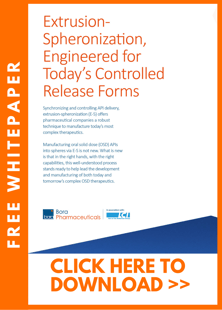Synchronizing and controlling API delivery, extrusion-spheronization is a robust technique offers pharmaceutical companies a reliable, efficient way to modify and control the release of many of today's insoluble drug compounds and manufacture the most effective patient-centric therapeutics.
Manufacturing spherical oral solid dose beads via extrusion-spheronization is a well-understood technology perfect for controlling and modifying the release of today’s insoluble, potent APIs. Suitable for a broad range of oral solid dose (OSD) therapeutics, extrusion-spheronization offers an efficient route to more effective, patient-centric therapeutics and a reliable way to manufacture complex OSD drug products.

A Comprehensive Way to Make Complex Oral Solid Dose Products
Development of extrusion-spheronization over the past decade has been accelerated by science’s more comprehensive understanding of the raw materials, active ingredients, processes, and controls behind the methodology. In addition, a greater understanding of how to manage and manipulate those inputs to increase therapeutic performance or modify API release (without compromising the integrity of the compound or molecule) has been vital. Extrusion-spheronization is a comprehensive manufacturing solution that addresses both product functionality and quality in the process.
A Growing Sphere of Therapeutic Influence
Extrusion-spheronization is an efficient, flexible and fast process for forming uniform pharmaceutical beads. The shape offers great utility to both drug developers and manufacturers. Offering a low surface area to volume ratio, spheronized active pharmaceutical ingredients offer several distinct advantages that improve the overall manufacturability of complex dose forms.
Offering superior flow and handling characteristics, spheronized beads offer an ideal shape for transport throughout most OSD manufacturing steps. Because extruded spheres offer improved hardness and reduced friability, they don’t generate dust—helping eliminate the possibility of contamination in processing—another of the sphere’s desirable “manufacturability” attributes.
Spheres are an optimal shape for manufacturing finished drug products, offering better packing and reproducibility in beds and columns and easier modelling because calculations are based on the flow around symmetrical bodies. Spheres are more mixable as well, especially for incompatible APIs. They can be loaded and packed uniformly into capsules faster and more reliably. The shape and density of spheres also promote uniform coating with less material, offering flexibility in manufacturing-controlled release characteristics.
Predictable, Controllable Oral Solid Dose Drug Delivery Vehicle

Extruded-spheronized pellets are recognized as a predictable vehicle for the control, distribution, and transportation of therapeutic agents around the body, making a variety of common and emerging controlled release dose forms possible.
This includes fixed-dose combinations (FDCs), combined modified-release single-capsule forms and emerging multi-unit particulate system (MUPS) tablets. Ultimately sphere-shaped pellets offer a variety of physical attributes that drug developers can leverage to control drug delivery, enhance therapeutic performance and aid the patient-centricity of oral solid dose drug products.
Extremely Viable Formulation Technique for Product Life Cycle Management
Extrusion-spheronization is proving to be an extremely versatile and economic manufacturing technique, viable for most of today’s OSD product development paths, including New Molecular Entities (NMEs), life-cycle management (LCM) extensions, and similar marketing strategies.
One area the technique shows great promise driving drug strategy is to support emerging 505(b)(2) development pathways including tailoring compounds for pediatric/geriatric applications or developing FDCs to create a new best-in-class patient-centric product.
Once a Day Dosing Means Better Patient Compliance
Patient preference is manifesting itself across the life sciences industry in many ways. Tailoring medications to better suit a particular patient population’s special needs or enhance healthcare’s ability to prescribe and administer treatments more efficiently, are all patient preference principles. But where the movement is being realized most profoundly is in drug engineering, with much of pharmaceutical R&D pursuing fundamental improvements to the therapeutic formulation, functionality, and form of OSD pharmaceutical products.
Modified release formulations can be effective for drug substances that have a narrow therapeutic index or need better dosage compliance. Most patient groups respond well to taking medications that are swallowed, but if a patient has to take their medications multiple times a day, dose compliance can be challenging.
Modifying release means better control of API dosing in-vivo. By managing uptake and bioavailability precisely, modified release formulations offer pharmaceutical drug developers a way to deliver their API with fewer doses. They can also better control release over time to deliver the desired therapeutic effect and reduce negative side effects associated with dose spiking.
Advanced Technologies Unlocking Extrusion-Spheronization Technology’s True Potential
The process and the equipment integral to extrusion-spheronization has advanced over time. The technology itself has seen steady improvement (along with a host of incumbent, tertiary systems) and consequently, some manufacturers may be better prepared to manufacture complex OSD drug products with this technique than others.
In the context of pharma manufacturing quality, current GMP thinking in extrusion-spheronization means incorporating Quality-by-Design (QbD) chemistry, state-of-the-art mixing, extruding and spheronizing equipment and entraining it in a continuous flow.
Pharma is relying more and more on its contract manufacturing partners to make increasingly complex drugs. For those seeking more strategic outsourcing relationships, it is now more important than ever to match drug strategy as closely as possible to the expertise and technical capabilities of your manufacturing partners.
More experienced project teams can help accelerate go-to-market schedules. Technical/operational mastery is a prerequisite. However to unlock extrusion-spheronization’s commercial potential, the process requires both experience and the investment operationally to do it well and meet all commercial, financial, and regulatory expectations.
